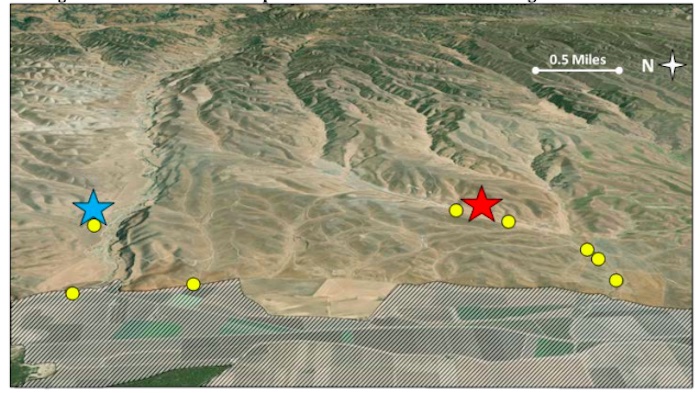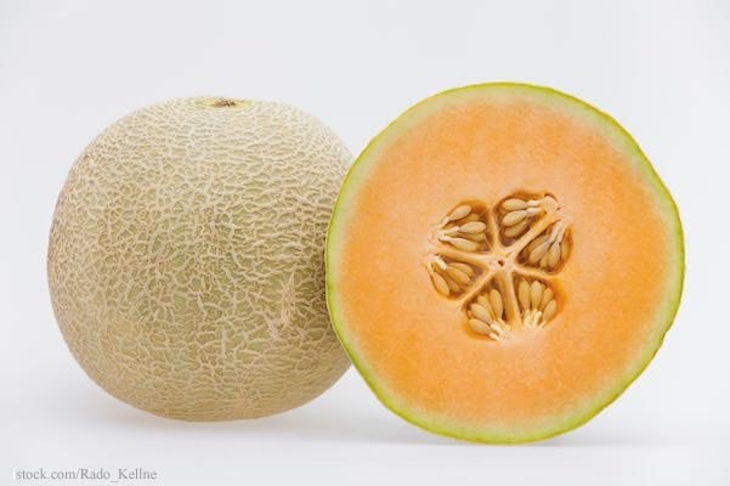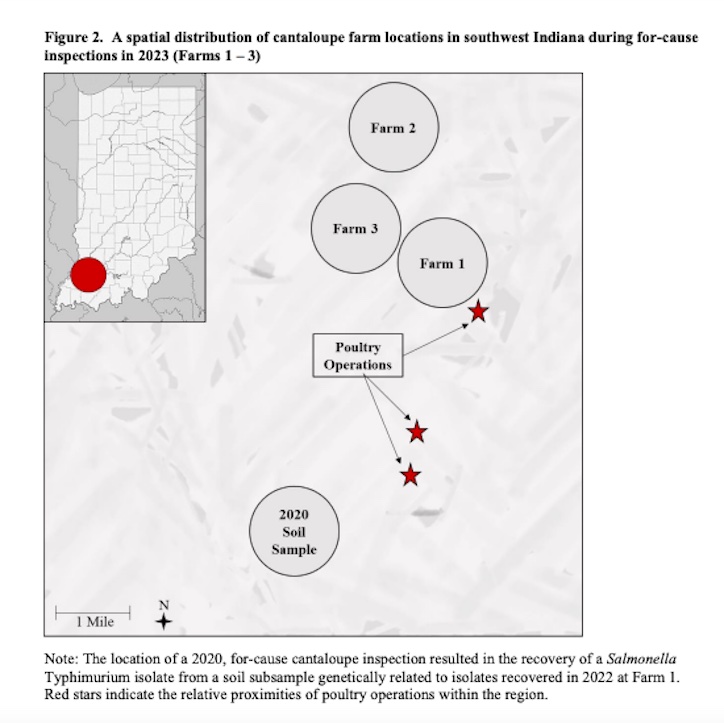Last week, the U.S. Food and Drug Administration (FDA) closed without solving its investigation of a Salmonella Newport outbreak that sickened 11 people in August. But information the agency gathered during its probe unearthed a troubling finding.
During interviews with patients, the Centers for Disease Control and Prevention (CDC) learned that people who got sick had eaten cantaloupe or watermelon before developing symptoms of Salmonella infections. Tracing the source of the melons back from the point of purchase, the FDA was able to determine that the melons were grown in Southwest Indiana.
Three environmental samples collected from farms there matched the outbreak strain of Salmonella Newport. Other samples from a “farm of interest and surrounding areas” were positive for Salmonella strains linked to previous outbreaks.
Does Indiana Cantaloupe have a Salmonella Problem?
The answer is yes, according to the FDA, which stated that its findings from this investigation “indicate continued presence of food safety concerns linked to melons from the Southwest Indiana growing region.
Southwest Indiana’s Salmonella Problem – More Than a Decade in the Making
How long has Southwest Indiana’s cantaloupe growing area has been plagued with food safety concerns? In 2012, cantaloupe grown in this area and contaminated with two strains of Salmonella (Typhimurium and Newport) caused 261 illnesses in 24 states and killed three people.
FDA investigators found multiple isolates of Salmonella, including the outbreak strains, in various growing locations at the farm.
They also discovered multiple food safety violations such as accumulated organic material on the cantaloupe conveyer; debris under the conveyer in the packinghouse including trash, wood, food pieces, standing water, mud, and dirt; standing water containing algae on the floor of the packinghouse; bird excrement in the rafters above food contact surfaces and directly on the processing line itself; roof runoff water flowing into brush washer and more.
An attorney representing the company at that time released a statement to local media outlets saying the outbreak wasn’t Chamberlain Farm’s fault. Tests performed by an independent microbiologist revealed that land adjacent to the melon fields was also contaminated with the outbreak strain, so that land must have been the likely source of the Salmonella outbreak, not Chamberlain Farms, he said.
The FDA’s view, expressed in a warning letter to the company, was a little different.
“FDA does not expect melons to be grown in a Salmonella-free environment; however these findings suggest a source of contamination that is widespread and not consistent with background contamination.” Filthy conditions on the farm likely contributed to the growth and spread of the bacteria, the agency said.
Good Agricultural Neighbors
The use of land adjacent to crops has long been an area of concern for the FDA. Numerous romaine lettuce E. coli outbreaks have put growing fields that neighbor cattle grazing areas or Concentrated Animal Feeding Operations (CAFOs) at center stage on this issue.

FDA image of romaine E. coli outbreak investigation. 2020 outbreak strain match is represented by a red star; 2019 outbreak strain is represented by blue star; other samples yielding STEC positives from the 2020 outbreak investigation are represented by yellow circles. The shaded area represents produce farms and ranches.
But proximity to livestock or poultry operations doesn’t absolve produce growers of responsibility to protect crops from contamination. On the contrary, the FDA says, it demands it.
Over the years, the agency has repeatedly recommended that leafy greens growers take action to protect their crops from E. coli and other pathogens shed in cattle manure. These actions include adding berms or physical barriers; creating diversion ditches and monitoring the quality of agricultural water.
The FDA made similar recommendations to melon growers neighboring poultry farms after the deadly 2012 outbreak and after a 2022 cantaloupe Salmonella outbreak.
Where is U.S. Cantaloupe Grown?
Indiana is one of about a dozen states that grow cantaloupe. Harvest of Indiana cantaloupe usually begins the first week of July and lasts about six weeks.
California is the nation’s largest producer of cantaloupe, followed by Arizona, according to the most recent data from the U.S. Department of Agriculture (USDA). Cantaloupe, sometimes called muskmelon, Is also grown in Colorado, Florida, Georgia, Illinois, Pennsylvania, Maryland, and North and South Carolina.
While most cantaloupe sold in the U.S. is domestically grown, imports have increased market share in recent years. Melons from Honduras, Guatemala, Costa Rica Mexico, and the Dominican Republic now regularly make their way to store shelves.

2022 Cantaloupe Salmonella Outbreak
In August 2022, cantaloupe grown in Southwest Indiana was linked to a Salmonella Typhimurium outbreak that sickened 88 people. Thirty-two people were hospitalized.
Illnesses were reported from 11 states: Georgia (1), Illinois (5), Indiana (17), Iowa (39), Kentucky (3), Michigan (3), Minnesota (4), Missouri (2), Ohio (3), South Carolina (1), and Wisconsin (10).
During its investigation, the FDA gathered information from three farms and one packinghouse in the Southwest Indiana growing region. However, all of the information was gathered after all growing, harvesting, and post-harvest activities were complete, so direct observation of these processes wasn’t possible.

In an FDA report on this investigation, the area surrounding these farms is described as “general cropping patterns in the region included grain, oilseed, and beans, interspersed with various vegetable crops, including melons. While locations of several poultry feeding operations were identified in the region during the investigation, their potential contributions to this outbreak investigation were not specifically determined.” It mentions heavy rainfall in the spring and again in the last week of July.
Genetic tests showed the outbreak strain was very similar to one that caused an outbreak in 2020.
Soil Samples collected from Farm 1
- Matched a Salmonella Typhimurium strain linked to three human illnesses reported between 2016 and 2018
- Were similar to the outbreak strain in 2022, samples collected from cantaloupe in 2013, isolates collected from Indiana ground turkey in 2016, and isolates from a 2020 Indiana soil subsample.
Soil Samples Collected from Farm 2
Yielded two Salmonella Newport strains
Salmonella Newport strain 1
- Matched a strain linked to 23 human illnesses reported between 2017 and 2022
- Matched samples collected from Farm 3
- Matched samples collected from the packinghouse
Salmonella Newport strain 2
- Matched a strain linked to three human illnesses in 2016, 209, and 2021
Soil Samples Collected from Farm 3
- Matched a strain linked to 23 human illnesses reported between 2017 and 2022
- Matched samples collected from Farm 2
- Matched samples collected from the packinghouse
Samples from the Packinghouse collected from the brush roller used for washing cantaloupes
- Matched a strain linked to 23 human illnesses reported between 2017 and 2022
- Matched samples collected from Farms 2 and 3
An Ongoing Assessment
The amount and diversity of Salmonella strains recovered from this area “may be indicative of robust human pathogen reservoirs which persist and circulate within this growing region,” the report states. “Considering these findings, the FDA is continuing an ongoing assessment of this region to better understand the presence of pathogens in the growing environment.”
The agency made several recommendations to the melon-growing industry and concluded the report by pledging to work with the Indiana State Department of Health to help the industry better understand the concentration of Salmonella in the area and promote risk-reduction strategies that will minimize the impact of these strains.
In the meantime, consumers can try to reduce the risk of bacteria on cantaloupe by trying this preparation method.




